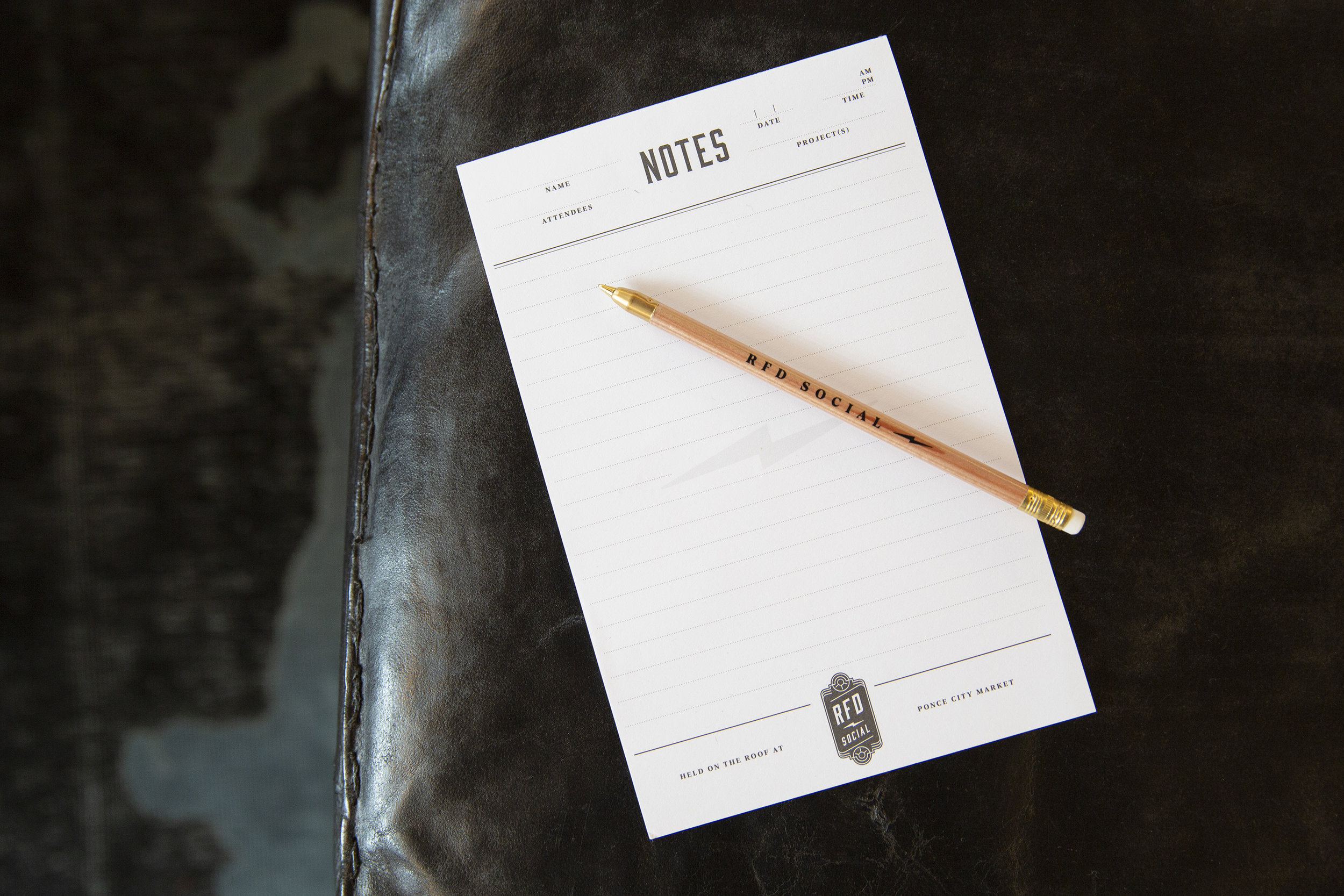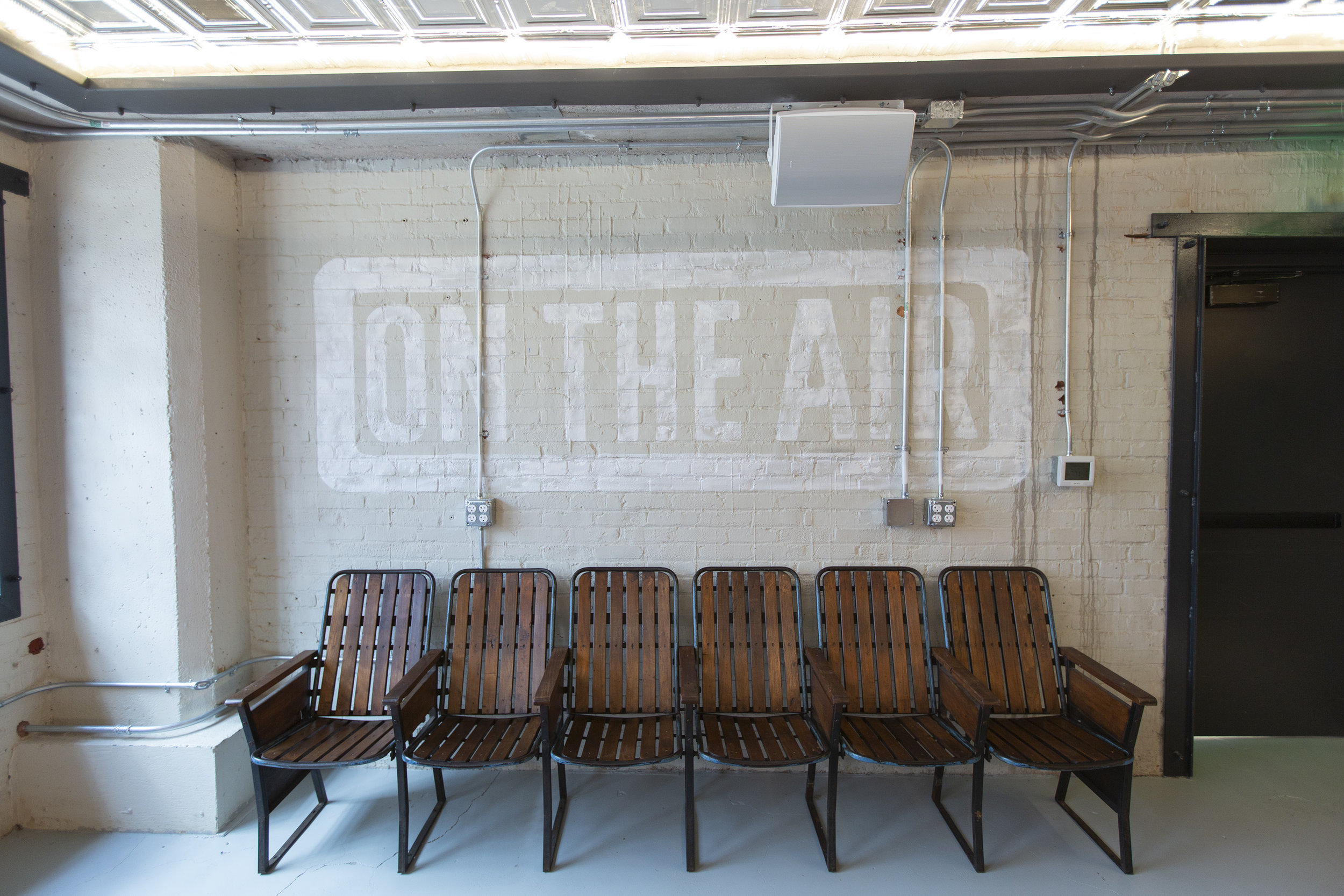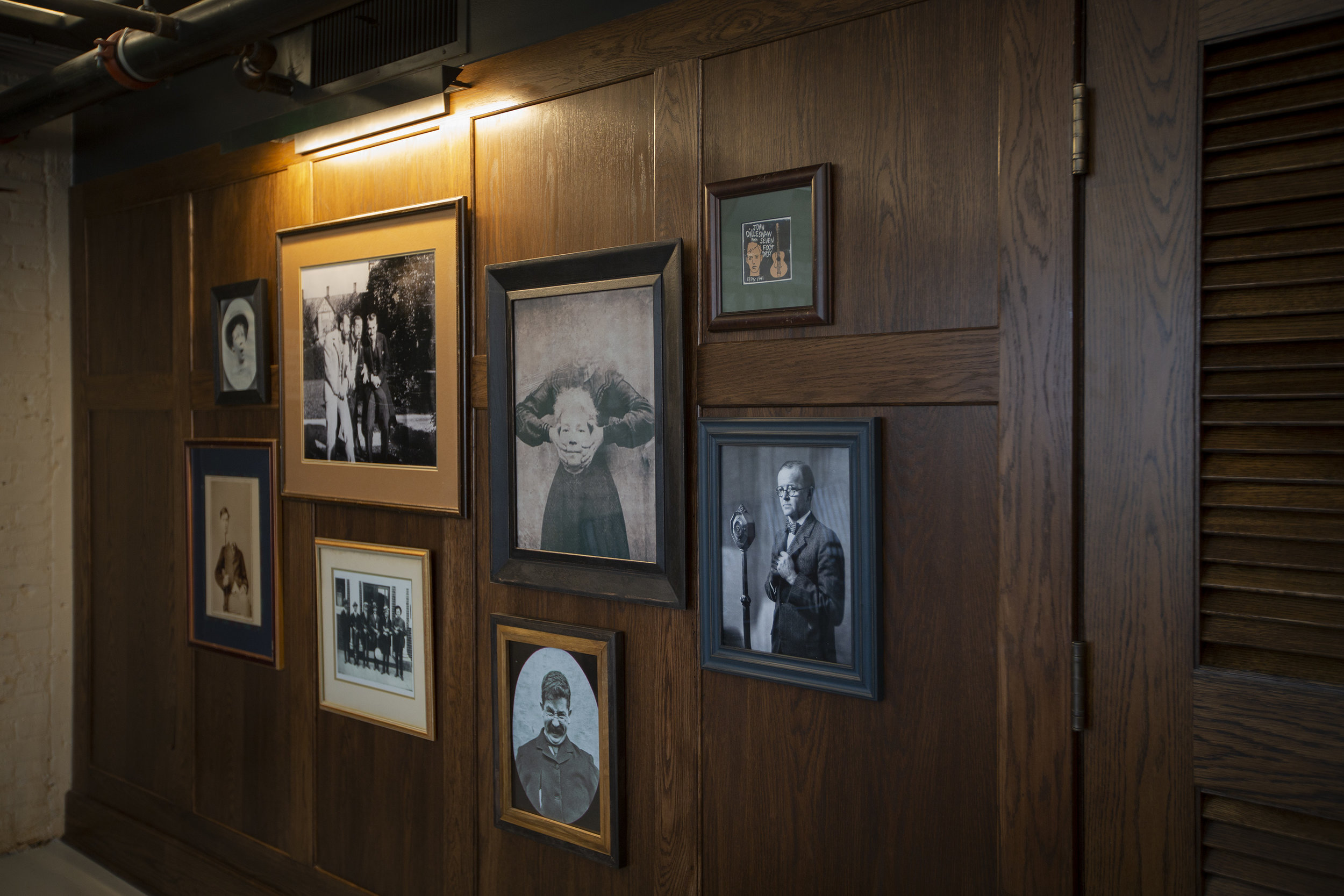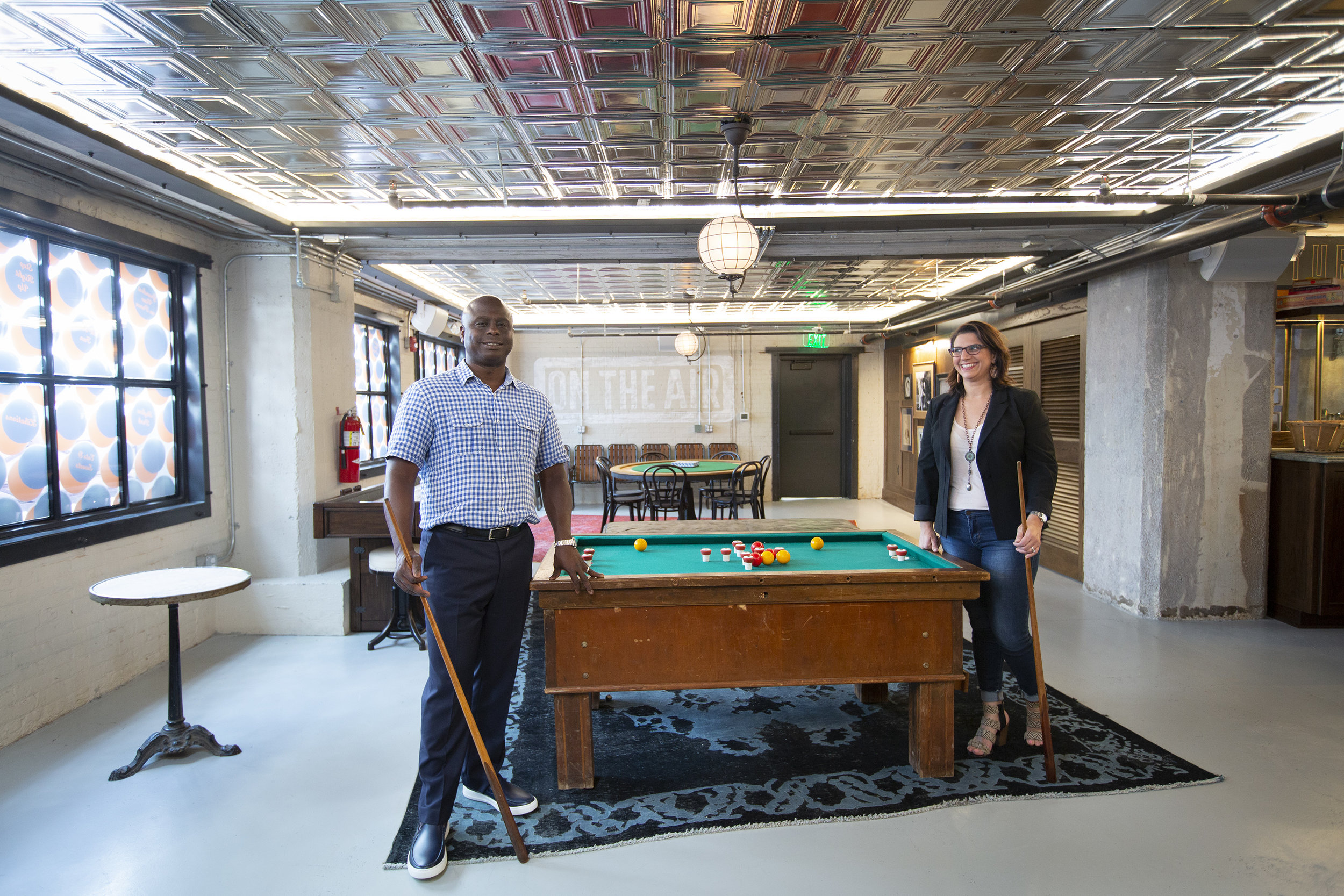Ninety years ago, the tower atop Atlanta’s Ponce City Market broadcast change across the South. Now, it’s the crowning achievement on the reclamation of one of our region’s most historic buildings.
Story by Jodi Cash | Photographs by Amanda Greene
Right smack dab in the middle of town,
I found a paradise that's trouble-proof.
And if this old world starts a-gettin’ you down
There's room enough for two, up on the roof.
— Carole King and Gerry Goffin, 1962
Here’s something you might not know: The country music industry was birthed in Atlanta years before it took root in Nashville. Country music caught hold of the South through a radio broadcast from that same tower atop the old Sears, Roebuck & Co. building.
Every Monday, Wednesday, and Friday at noon, “Dinner Bell R.F.D.,” which stood for Radio Farmer’s Democracy, soared over the airwaves. (Back then in the South, lunch was called dinner, and dinner was supper.) From 1926 to 1928, “Dinner Bell” was one of the most beloved programs on WSB, not just the first station in Atlanta, but also the first radio station to broadcast from the South.
It took off soon after Sears & Roebuck opened their doors to Atlanta in 1926 and fostered goodwill between their new home and the people who had been there a long, long time.
Sears saw great luck with the Agricultural Foundation it launched in 1923. This offshoot of the company had two purposes: Help farmers make more money, then get the farmers to spend some of that money at Sears.
They channeled what they knew from the Agricultural Foundation and created a program featuring the things they knew Southerners loved best and needed most: old-timey, hillbilly music and tried, true farming advice.
In a 1974 interview stashed deep in the company archives, Sears’ first ever public relations director, J.C. Haynes, says, “Everybody in the South had little bitty radio sets.”
And so Sears met its new customers where they were — huddled around radios.
Relics from the 1920s broadcasting era of the tower atop Atlanta's Ponce City Market.
The show featured what was fondly called “hillbilly music,” a rustic assemblage of twanging, old-time country music plucked on banjos, strummed on guitars, bowed on fiddles, and sung in tight harmonies on porches, in churches, and at hoedowns throughout the South.
That sound was already familiar in the region’s culture, but it was relatively new to the radio world. WSB was the first station to broadcast music like this, targeted at rural people. And for listeners and country musicians alike, that was revolutionary.
The show always opened with the ringing of a dinner bell, a symbolic sound for people coming off of the farm, taking refuge from the heat and pausing for a midday meal. Dewey Burnett, a musician acclaimed for his harmonica and fiddle playing hosted it.
Listeners could also become members by sending in a request to hear a song or to have a question answered about their farm.
There was farming and homemaking advice. There was entertainment. There was community in gathering around the radio to hear the program. But most importantly, there was music.
“The Nashville business really started in that studio,” says Haynes.
The show featured music from acts like Fiddlin’ John Carson, the Slaughter Sisters, Jep Tatum, Gid Tanner and the Skillet Lickers, and the Wompus Cats. They were among the first country music acts to be recorded and gain fame.
“Dinner Bell R.F.D.” was just one of the spells Sears cast over the South, and they knew precisely what they were doing. It solidified the company’s tenure in the region. It laid the groundwork for Sears’ even more influential agricultural programs, like farmers markets and farm extension programs.
And when it left WSB’s programming in 1928, it had seeped heavily into the programming of Sears’ other stations. Country music became a staple nationwide. Rural people were being heard.
Now, two restaurateurs are transforming that historic rooftop into the kind of place where people can gather in the city, just like they gathered around their radios in the country all those years ago.
Mandy and Kelvin Slater don’t create spaces they wouldn’t enjoy. The Atlanta restaurateurs met in the industry, and their love was founded on their shared appreciation for what makes a place suitable for gathering: ambiance, flavor, community.
When reclamation of the old Sears building on Ponce de Leon Avenue transformed the space into the play-work-live mecca that is Ponce City Market, the Slaters were presented with a premiere opportunity — to develop the rooftop into a destination.
Since the official establishment of Ponce City Market, Slater Hospitality has opened Skyline Park, Nine Mile Station, and Rooftop Terrace. Skyline Park, a miniature amusement park, is themed around the amusement park that once occupied the block where the building was erected in 1926. Nine Mile Station, a restaurant and bar, hearkens to the trolley stop where Victorian-era Atlantans would hop off to enjoy the park on Ponce. The Rooftop Terrace is an elegant event space, which fits into the rooftop’s artful balance of old and new.
And in the years since they unveiled those spaces, the Slaters have turned their eyes to the Tower, a four-story icon in the building’s silhouette.
Kelvin and Mandy Slater designed The Parlour at R.F.D. to guide guests away from the stresses of everyday digital life.
Determining how to use the additional feature wasn’t easy — there’s really nothing obvious about renovating a tower for public use — but the necessity to think outside of the obvious is precisely the challenge Mandy and Kelvin Slater love. As it was, the top floor of the tower remains untouched, with the water tower still active and intact.
“It was a difficult space to envision anything in,” says Mandy. “Basically, we had this great space with all these different levels and then we kind of fit the concept to fit the space. It wasn't like we had this great concept and, ‘Oh, this is where we want to do it!’ It just was the other way around.”
While they imagined what could be, they thought about what was. In keeping with the rest of the rooftop and the building at large, they knew they’d draw on history.
And so began a journey of research.
The idea of a Radio Farmers Democracy resonated with Mandy and Kelvin Slater for a long time.
But it wasn’t readily apparent where and how the radio concept would come into play on the roof. It was hard to envision how the rooftop and tower would embody any concept at all, thanks to its complicated layout.
Then, it occurred to the Slaters that this space lent itself seamlessly to recreating the spirit of R.F.D., true to its purpose of leisure, enlightenment, community, and connectedness, with a fresh spin on what the radio once meant to the South.
The idea of stepping back in time here is about more than maintaining historical integrity — it’s about giving people the chance to connect IRL.
A gallery of scenes inside The Parlour
Their vision for the rooftop began in a time when the entire building was in a state of dire disrepair.
Sears operated their regional headquarters and catalog shipping operation from the building from 1926 to 1989. What happened in the building, and because of it, had a drastic impact across the South. Sears helped assuage the problem of racism in retail. Sears offered sorely needed goods to rural folks. It offered jobs to thousands of people who drove into the city from miles away to benefit from the company’s generous profit-sharing and benefits.
But one thing led to another, and the doors shuttered in the late 1980s, and the city of Atlanta later bought the building to use as City Hall East, a project which proved much too costly for the city to sustain.
Flash forward to 2011 when real estate developer Jamestown purchased the building with a sweeping aspiration for what it could become. They held true to the building’s original purpose as a place for communion.
The Slaters believed it was time to give the city a space it deserved — to reclaim untapped promise and offer a new perspective.
The dominating view beyond Kit Sutherland’s office window was a parking garage. More specifically, she saw a parking garage serving no one, a deck intended for the filled-to-the-brim version of a then defunct building. And occasionally, she saw flashlights and suspicious signs of delinquent activity.
For Sutherland, who studied architectural history as an undergrad and earned a master's degree in historic preservation planning from Georgia State University, this was disappointing. She and her husband have lived in the neighborhood since 1984, and Southerland always had strong feelings about the building, which she refers to affectionately as “The Big Girl.”
By the early ’90s, when Sutherland settled in, Sears had closed, and the city had taken over, the building became problematic. In the 20 years that followed, it progressively worsened.
“The building was dying from lack of activity and lack of engagement,” she says. “You couldn't walk into the property. You couldn't engage with the property. The property had little public function anymore. It was no longer doing what it had done historically, and it wasn't doing what the neighborhood would want it to be. It was just there.”
Neighborhood activist Kit Sutherland says the Sears building's resurrection as Ponce City Market "has been a massive catalyst for the redevelopment of the rest of the neighborhood.”
Kit became a vocal advocate for community projects like the Old Fourth Ward Park, the Beltline, and Ponce City Market. She was one of the neighborhood’s most prominent voices, pushing for sensible solutions that brought real vitality and not just prosperity to the area.
The plans worked, and the trifecta of reused spaces have become internationally exemplary.
“It has been a massive catalyst for the redevelopment of the rest of the neighborhood,” she says. “Lots that sat vacant for years, houses that were vacant for years, places that nobody wanted to go — they're popping now. The Beltline, Ponce City Market, and Old Fourth Ward Park are revitalizing this neighborhood in a way that nothing else could have, beyond everyone's wildest dreams.”
From the beginning, the Slaters have taken their responsibility to the city and the neighborhood seriously. And because they’ve been involved with developing the roof since shortly after PCM’s doors opened to the public, they’ve had the chance to meet people whose whole lives revolved around what the building was formerly.
Still, they find themselves regularly reminded of how significant the building is to so many.
Mandy remembers a day when she rushed onto the freight elevator — an important historical element to the building, and the public’s only access route to the roof. Despite her hurry, she noticed an older gentleman looking around at each detail of the elevator car. She struck up a conversation with him, and he revealed he’d spent decades working as that elevator’s operator.
The Slaters try not to take their work for granted.
“My favorite thing is to stand there at night and watch people come off the freight elevator and come outside for the first time,” she says. “It never gets old.”
The view from the tower over the rooftop's Skyline Park.
The inspiration from people returning to the building for the first time in decades and the people who are seeing its best view for the first time both serve as motivation for the Slaters.
These are the encounters that remind the Slaters of their duty to the history of the building and its longevity. It’s not because of any Historic Places plaque; nor is it about modern-day trend value. It’s about people from different times walking the same path.
“We have a big responsibility to keep it fresh and interesting,” says Kelvin. “And to be able to tell the story because I think a lot of people want to know the story.”
And with R.F.D. opening this month, there’s a whole new chapter of the story available to the public.
When you enter R.F.D., history seems to crackle through the air.
Perhaps it’s the remnants of radio waves, hung on long-stifled air, or maybe it’s the spirit of old Dewey Burnett, doing an eternal broadcast in the sky. Whatever it may be, when you step off of the elevator into The Parlour at R.F.D., you feel the essence of a different time.
Whether you arrive directly by freight elevator or you come through the doors after traipsing around the rest of the rooftop park, when you step through the doors into The Parlour, you’re transported to a different moment for leisure and luxury.
“We'd like to say, once you know the story and you walk into the space, you get it,” says Kelvin.
The details behind the bar point to the South’s experience of the Roaring Twenties. Antique punching bags, leather roller skates, wooden golf clubs, a set of horseshoes, and delicate badminton rackets are a reminder of the way sport took hold when leisure became accessible even to common folks.
Art deco lettering, metallic barware, brass light fixtures, and sleek, clean lines provide the still-coveted elements of style that defined the period.
As your eyes are drawn to the wider Parlour, you’ll notice even more references to the tower’s remarkable history. A historical Dinner Bell R.F.D. ad is painted on a mirror, and antique radios and radio microphones rest artfully on shelves.
Photography was among the many cultural entities upended before the Roaring Twenties.
“They just started to learn that they could manipulate photography in the Victorian age,” says Kelvin. “They very often took their heads off and thought it was cute.” And sure enough, on the walls of The Parlour, there are framed photographs of people who appear to be holding their own heads, plus other distorted images from that the era.
In the same galleries, there are framed newspaper clippings and photographs of musicians who found fame on the Dinner Bell R.F.D.
Although The Parlour is as comfortable as our modern tastes desire, it’s designed to guide guests out of their worlds of digital distractions. Sure, it’s Instagrammable (if you must) but there are no TVs hanging from the walls — there are, instead, elements to encourage engaging with friends and fellow guests.
Here, contemporary customers can revive themselves and engage with one another in ways that people did almost 100 years ago. Bring friends and play games like bumper pool, table top shuffleboard, or even poker at an antique table.
“I think, as much as everyone wants to move forward in progress, everybody still wants to keep things simple and keep life simple,” says Mandy. “You know, eat around a dinner table and talk, and I think that's what we've tried to do in R.F.D. Just keep it very social.”
Every facet of R.F.D. bears a relationship to the building’s history, but it was also the product of the Slater’s authentic hospitality.
“We were listening to what people were asking. And there was a need for a space that could accommodate 75 or 100 people for events, and then we knew the bar that we needed an additional bar to help whenever there was rain or it was too hot, they can come inside and spend time there,” says Kelvin. “So, this really kind of grew itself into a concept. We just listened and then put our own spin on it.”
Outside of the public Parlour, the Roebuck Room was built to serve private crowds.
There’s a grand ballroom which suits anything from dance parties to conference events. Pared back to the building’s bones, the room allows the floor-length windows and original columns to steal the show.
There’s a long table sectioned off in the Roebuck Room, optimal for meetings, with every element conducive to both creativity and productivity. It’s a room where you might imagine Richard Sears and Alvah Roebuck themselves discussing their entrée into the South. It’s equipped for the digital needs of modern business, but there are also analog options — sharpened pencils and signature notebooks.
The Roebuck Room is aptly named. For all the ways that Richard Sears embodied Barnumesque levels of charm and savvy, clever as a chimpanzee and smooth as a rattlesnake, Alvah Curtis Roebuck was the grounding force, the sensible man. Roebuck was all business.
This is visible in the contrast of the rooftop amusements with the cosmopolitan business space. The colors, furniture, and art inside the Roebuck Room are sophisticated and understated.
There’s one lasting secret in the renovated tower, and it’s called 12. This space is all about exclusivity, and should you ever get the chance to see it, you’ll know why.
“Everything in the building is so old and feels so original. We wanted people to come up here and be like, ‘This is completely different from anything you're going to see anywhere else on the property,’” says Mandy.
It’s worth pulling whatever strings you have to get there — even just to say you made it, to know what’s hiding on the final floor.
Now, when Kit Sutherland looks out her window, she can spot the flag blowing on the rooftop and the words Ponce City Market brightly illuminated.
She enjoys the democratic offering of festive lights that glow different colors for different occasions in the tower. Around the holidays, she loves the red and green. During Pride, there are rainbow colors. On the Fourth of July, she looks forward to seeing her neighborhood illuminated in red, white, and blue.
“I always think making the most of what you have in real estate is clever,” Sutherland says. “In Europe, roofs are routinely used for terraces and seating and all of that, and we don't do enough of it in this country, so I'm happy to see that.”
And aside from her day-to-day enjoyment of seeing a building fulfilling even more than what she thought was its full potential, she particularly appreciates what it’s like to stand on that rooftop.
“The view is just extraordinary,” she says. “For anyone who cares about cities and the way the streets lay out, and how the Beltline works, when you're standing up there, it clicks. I mean you see it. You see, wow, this is where Ponce de Leon intersects the Beltline, which used to be the railroad, and that's why this building is here. This is where the No. 2 trolley used to run, and gosh, that's The Georgian Hotel and the Fox Theater at the end, and that clicks. And so for people who are not spatially-oriented and maybe don't look at a map, suddenly you get up there, and there's a map laid out when you look down on the street, and the map is the lay of the land.”
Here, perhaps better than anywhere else, you can see how the neighborhood came to be. And looking out across town, you can imagine the city’s future.
Ponce City Market is unique in its multidimensional homage to the neighborhood’s history and its drastic impact on the neighborhood’s future. The rooftop plays into that balance perfectly — it’s both a thoughtful look at the way things were and a gracious offering to generations to come.
And with R.F.D., the Slaters have done what felt unthinkable, even to them — they’ve brought even more new life to all four floors of the tower.
But just like time goes on and change never stops, the Slaters plan to keep moving and to let the space keep evolving.
“It's a huge honor and a privilege, and I'm thrilled that we're the ones that get to do it,” Mandy says. “It's been great for us, we've learned a lot, we've grown a lot, and we're excited for the future here.”
JOIN US ON THE ROOF
Join Slater Hospitality and Bitter Southerner for The Revival of Ponce City Market’s iconic Tower. The celebration will showcase the newest rooftop space and its former life, Thursday, July 12, from 7 p.m.-11 p.m.
Enjoy a performance by local indie rock fixtures, Quiet Hounds, a theatrical production inspired by Dinner Bell R.F.D., hors d'oeuvres by Nine Mile Station’s executive chef Jonathan McDowell, and thematic cocktails.
Tickets are $95 and can be purchased at poncecityroof.com.

























